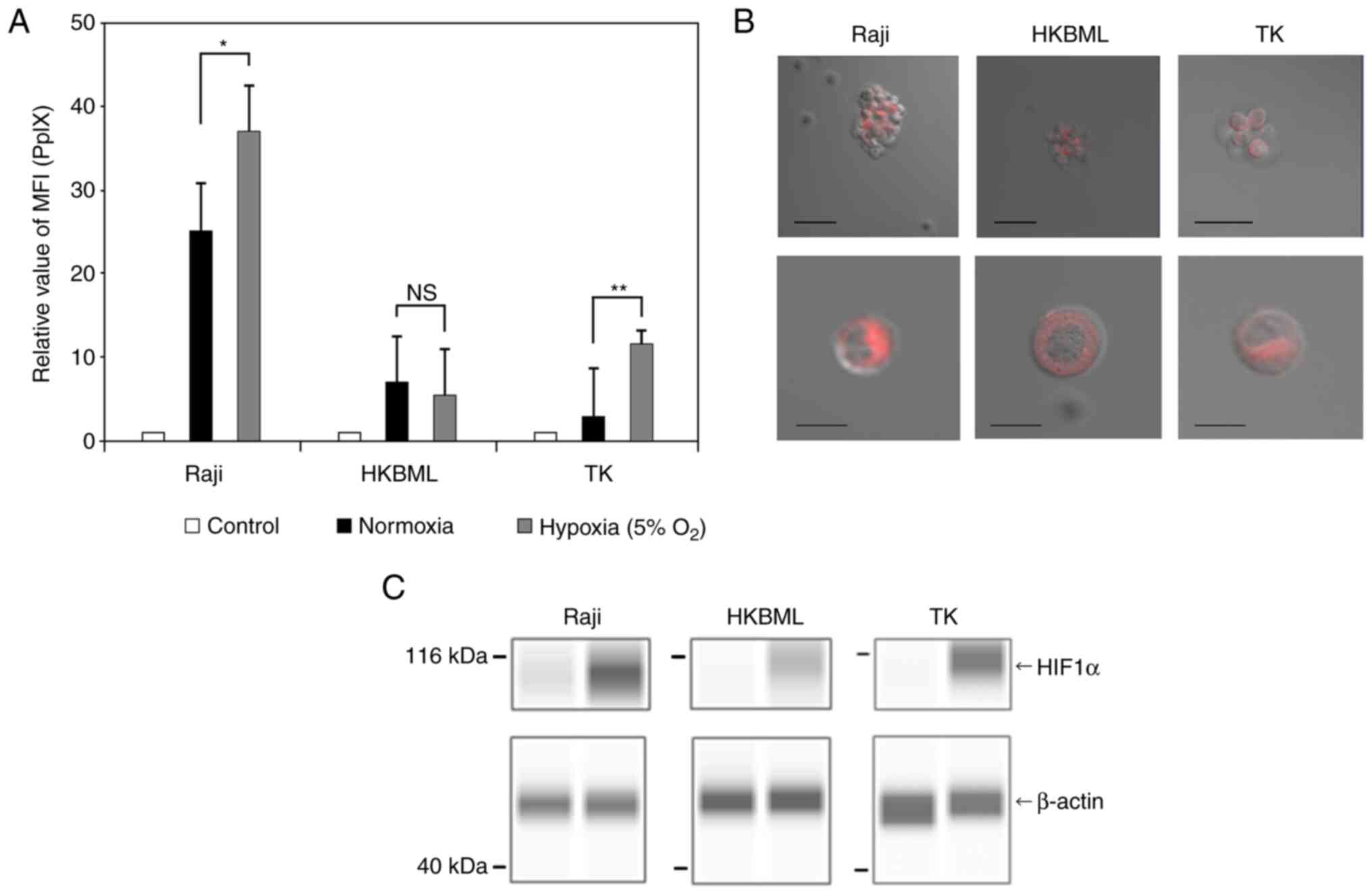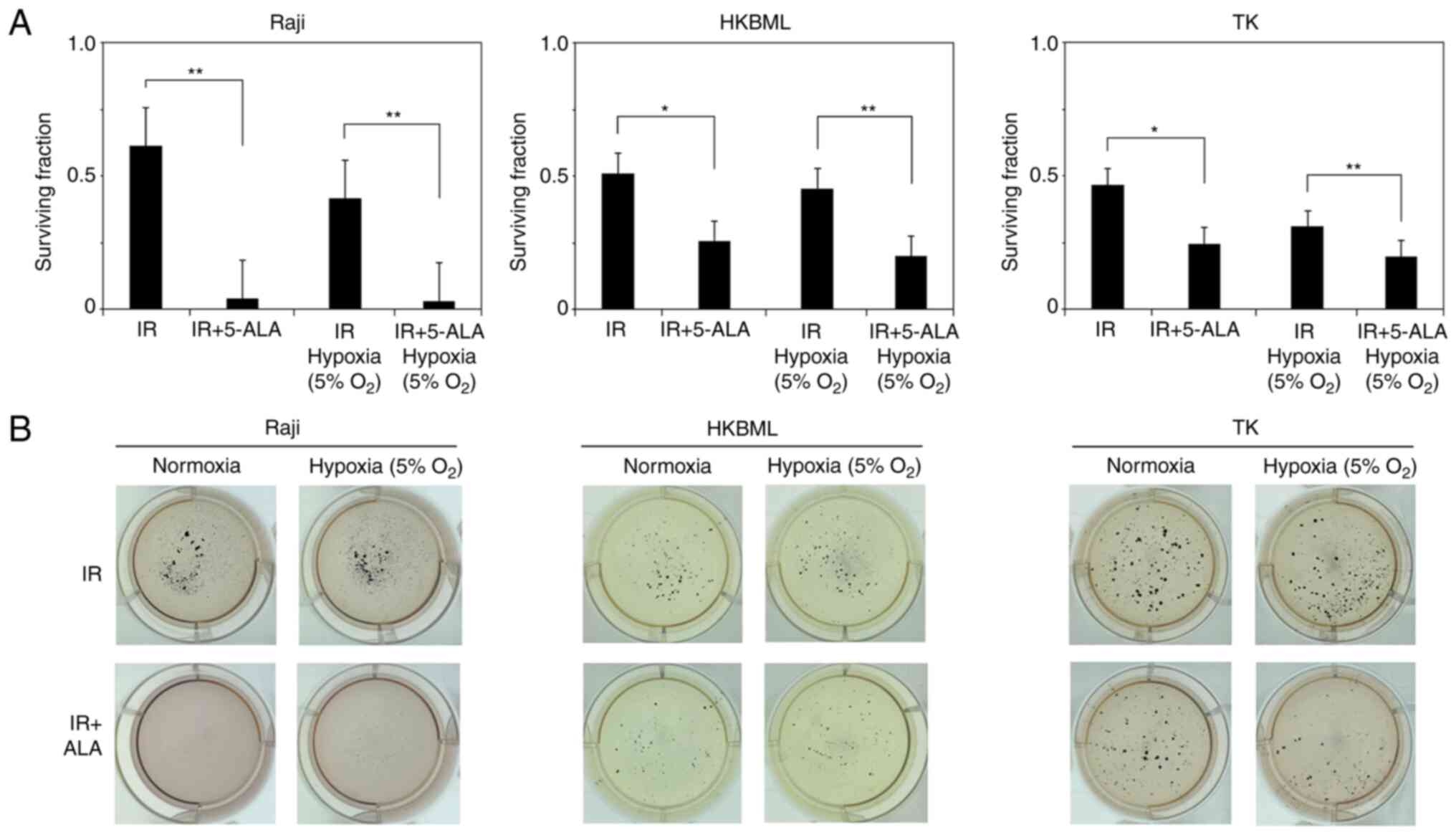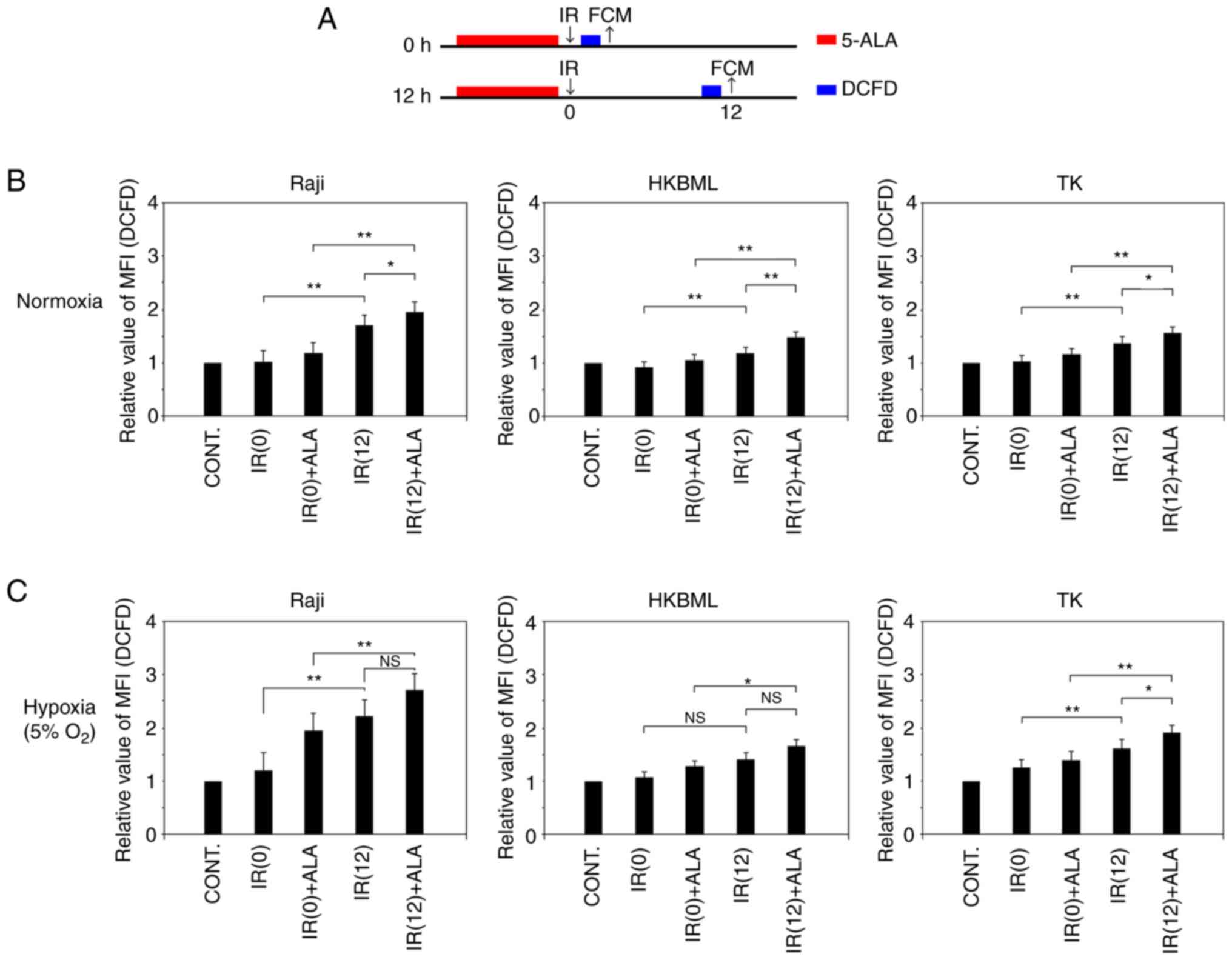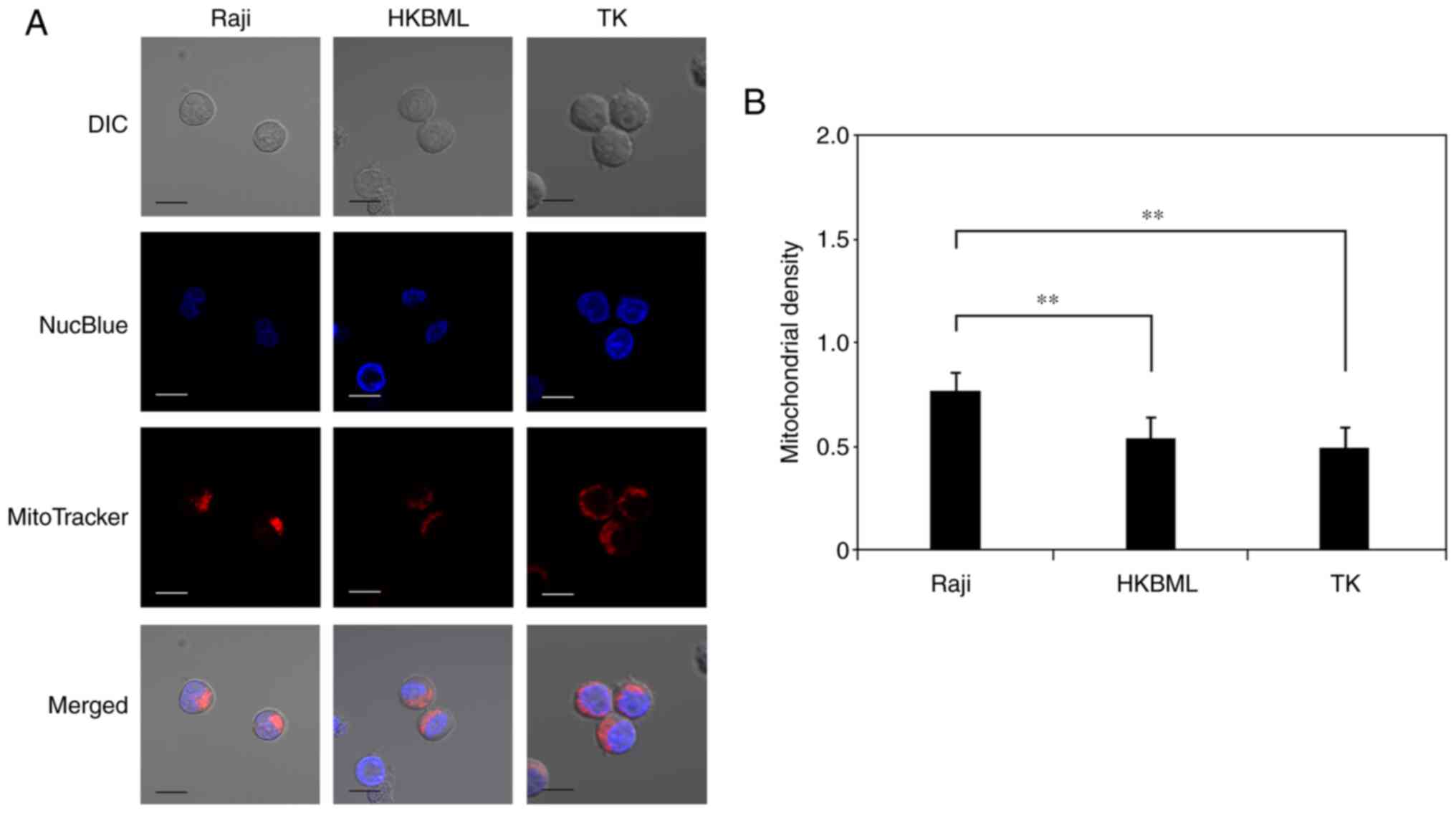|
1
|
Han CH and Batchelor TT: Diagnosis and
management of primary central nervous system lymphoma. Cancer.
123:4314–4324. 2017.PubMed/NCBI View Article : Google Scholar
|
|
2
|
Siegal T and Bairey O: Primary CNS
lymphoma in the elderly: The challenge. Acta Haematol. 141:138–145.
2019.PubMed/NCBI View Article : Google Scholar
|
|
3
|
Ferreri AJ and Marturano E: Primary CNS
lymphoma. Best Pract Res Clin Haematol. 25:119–130. 2012.PubMed/NCBI View Article : Google Scholar
|
|
4
|
Calimeri T, Steffanoni S, Gagliardi F,
Chiara A and Ferreri AJM: Erratum to ‘How we treat primary central
nervous system lymphoma’: [ESMO Open Volume 6, Issue 4, August
2021, 100213]. ESMO Open. 6(100326)2021.PubMed/NCBI View Article : Google Scholar
|
|
5
|
Ishizuka M, Abe F, Sano Y, Takahashi K,
Inoue K, Nakajima M, Kohda T, Komatsu N, Ogura S and Tanaka T:
Novel development of 5-aminolevurinic acid (ALA) in cancer
diagnoses and therapy. Int Immunopharmacol. 11:358–365.
2011.PubMed/NCBI View Article : Google Scholar
|
|
6
|
Stummer W, Pichlmeier U, Meinel T,
Wiestler OD, Zanella F and Reulen HJ: ALA-Glioma Study group.
Fluorescence-guided surgery with 5-aminolevulinic acid for
resection of malignant glioma: A randomised controlled multicentre
phase III trial. Lancet Oncol. 7:392–401. 2006.PubMed/NCBI View Article : Google Scholar
|
|
7
|
Stummer W, Holling M, Bendok BR, Vogelbaum
MA, Cox A, Renfrow SL, Widhalm G, Ezrin A, DeSena S, Sackman ML and
Wyse JW: The NXDC-MEN-301 Study on 5-ALA for meningiomas surgery:
An innovative study design for the assessing the benefit of
intra-operative fluorescence imaging. Brain Sci.
12(1044)2022.PubMed/NCBI View Article : Google Scholar
|
|
8
|
Kiesel B, Millesi M, Woehrer A, Furtner J,
Bavand A, Roetzer T, Mischkulnig M, Wolfsberger S, Preusser M,
Knosp E and Widhalm G: 5-ALA-induced fluorescence as a marker for
diagnostic tissue in stereotactic biopsies of intracranial
lymphomas: Experience in 41 patients. Neurosurg Focus.
44(E7)2018.PubMed/NCBI View Article : Google Scholar
|
|
9
|
Takahashi J and Misawa M: Characterization
of reactive oxygen species generated by protoporphyrin IX under
X-ray irradiation. Radiat Phys Chem. 78:889–898. 2009.
|
|
10
|
Ueta K, Yamamoto J, Tanaka T, Nakano Y,
Kitagawa T and Nishizawa S: 5-Aminolevulinic acid enhances
mitochondrial stress upon ionizing irradiation exposure and
increases delayed production of reactive oxygen species and cell
death in glioma cells. Int J Mol Med. 39:387–398. 2017.PubMed/NCBI View Article : Google Scholar
|
|
11
|
Yamamoto J, Ogura S, Shimajiri S, Nakano
Y, Akiba D, Kitagawa T, Ueta K, Tanaka T and Nishizawa S:
5-aminolevulinic acid-induced protoporphyrin IX with multi-dose
ionizing irradiation enhances host antitumor response and strongly
inhibits tumor growth in experimental glioma in vivo. Mol Med Rep.
11:1813–1819. 2015.PubMed/NCBI View Article : Google Scholar
|
|
12
|
Yamamoto J, Ogura S, Tanaka T, Kitagawa T,
Nakano Y, Saito T, Takahashi M, Akiba D and Nishizawa S:
Radiosensitizing effect of 5-aminolevulinic acid-induced
protoporphyrin IX in glioma cells in vitro. Oncol Rep.
27:1748–1752. 2012.PubMed/NCBI View Article : Google Scholar
|
|
13
|
Kitagawa T, Yamamoto J, Tanaka T, Nakano
Y, Akiba D, Ueta K and Nishizawa S: 5-Aminolevulinic acid strongly
enhances delayed intracellular production of reactive oxygen
species (ROS) generated by ionizing irradiation: Quantitative
analyses and visualization of intracellular ROS production in
glioma cells in vitro. Oncol Rep. 33:583–590. 2015.PubMed/NCBI View Article : Google Scholar
|
|
14
|
Takahashi J, Murakami M, Mori T and
Iwahashi H: Verification of radiodynamic therapy by medical linear
accelerator using a mouse melanoma tumor model. Sci Rep.
8(2728)2018.PubMed/NCBI View Article : Google Scholar
|
|
15
|
Yamada K, Murayama Y, Kamada Y, Arita T,
Kosuga T, Konishi H, Morimura R, Shiozaki A, Kuriu Y, Ikoma H, et
al: Radiosensitizing effect of 5-aminolevulinic acid in colorectal
cancer in vitro and in vivo. Oncol Lett. 17:5132–5138.
2019.PubMed/NCBI View Article : Google Scholar
|
|
16
|
Miyake M, Tanaka N, Hori S, Ohnishi S,
Takahashi H, Fujii T, Owari T, Ohnishi K, Iida K, Morizawa Y, et
al: Dual benefit of supplementary oral 5-aminolevulinic acid to
pelvic radiotherapy in a syngenic prostate cancer model. Prostate.
79:340–351. 2019.PubMed/NCBI View Article : Google Scholar
|
|
17
|
Kaneko T, Tominaga M, Kouzaki R, Hanyu A,
Ueshima K, Yamada H, Suga M, Yamashita T, Okimoto T and Uto Y:
Radiosensitizing effect of 5-aminolevulinic acid and protoporphyrin
IX on Carbon-ion beam irradiation. Anticancer Res. 38:4313–4317.
2018.PubMed/NCBI View Article : Google Scholar
|
|
18
|
Yang DM, Cvetkovic D, Chen L and Ma CC:
Therapeutic effects of in-vivo radiodynamic therapy (RDT) for lung
cancer treatment: A combination of 15MV photons and
5-aminolevulinic acid (5-ALA). Biomed Phys Eng Express.
8(1088/2057-1976/ac9b5c)2022.PubMed/NCBI View Article : Google Scholar
|
|
19
|
Wang J, Valdez A and Chen Y: Evaluation of
automated Wes system as an analytical and characterization tool to
support monoclonal antibody drug product development. J Pharm
Biomed Anal. 139:263–268. 2017.PubMed/NCBI View Article : Google Scholar
|
|
20
|
Baddela VS, Sharma A, Michaelis M and
Vanselow J: HIF1 driven transcriptional activity regulates
steroidogenesis and proliferation of bovine granulosa cells. Sci
Rep. 10(3906)2020.PubMed/NCBI View Article : Google Scholar
|
|
21
|
Prall F, Maletzki C and Linnebacher M:
Microdensitometry of osteopontin as an immunohistochemical
prognostic biomarker in colorectal carcinoma tissue microarrays:
Potential and limitations of the method in ‘biomarker pathology’.
Histopathology. 61:823–832. 2012.PubMed/NCBI View Article : Google Scholar
|
|
22
|
Yamamori T, Yasui H, Yamazumi M, Wada Y,
Nakamura Y, Nakamura H and Inanami O: Ionizing radiation induces
mitochondrial reactive oxygen species production accompanied by
upregulation of mitochondrial electron transport chain function and
mitochondrial content under control of the cell cycle checkpoint.
Free Radic Biol Med. 53:260–270. 2012.PubMed/NCBI View Article : Google Scholar
|
|
23
|
Saenko Y, Cieslar-Pobuda A, Skonieczna M
and Rzeszowska-Wolny J: Changes of reactive oxygen and nitrogen
species and mitochondrial functioning in human K562 and HL60 cells
exposed to ionizing radiation. Radiat Res. 180:360–366.
2013.PubMed/NCBI View Article : Google Scholar
|
|
24
|
Dupin C, Sutter J, Amintas S, Derieppe MA,
Lalanne M, Coulibaly S, Guyon J, Daubon T, Boutin J, Blouin JM, et
al: An orthotopic model of glioblastoma is resistant to
radiodynamic therapy with 5-AminoLevulinic acid. Cancers (Basel).
14(4244)2022.PubMed/NCBI View Article : Google Scholar
|
|
25
|
Galadari S, Rahman A, Pallichankandy S and
Thayyullathil F: Reactive oxygen species and cancer paradox: To
promote or to suppress? Free Radic Biol Med. 104:144–164.
2017.PubMed/NCBI View Article : Google Scholar
|
|
26
|
Owari T, Tanaka N, Nakai Y, Miyake M, Anai
S, Kishi S, Mori S, Fujiwara-Tani R, Hojo Y, Mori T, et al:
5-Aminolevulinic acid overcomes hypoxia-induced radiation
resistance by enhancing mitochondrial reactive oxygen species
production in prostate cancer cells. Br J Cancer. 127:350–363.
2022.PubMed/NCBI View Article : Google Scholar
|
|
27
|
Nordmann NJ and Michael AP:
5-Aminolevulinic acid radiodynamic therapy for treatment of
high-grade gliomas: A systematic review. Clin Neurol Neurosurg.
201(106430)2021.PubMed/NCBI View Article : Google Scholar
|
|
28
|
Krivoshapkin A, Gaytan A, Abdullaev O,
Salim N, Sergeev G, Marmazeev I, Cesnulis E, Killeen T, Tyuryn V,
Kiselev R, et al: Prospective comparative study of intraoperative
balloon electronic brachytherapy versus resection with
multidisciplinary adjuvant therapy for recurrent glioblastoma. Surg
Neurol Int. 12(517)2021.PubMed/NCBI View Article : Google Scholar
|
|
29
|
Pepper NB, Stummer W and Eich HT: The use
of radiosensitizing agents in the therapy of glioblastoma
multiforme-a comprehensive review. Strahlenther Onkol. 198:507–526.
2022.PubMed/NCBI View Article : Google Scholar
|
|
30
|
Higgins GS, O'Cathail SM, Muschel RJ and
McKenna WG: Drug radiotherapy combinations: Review of previous
failures and reasons for future optimism. Cancer Treat Rev.
41:105–113. 2015.PubMed/NCBI View Article : Google Scholar
|
|
31
|
Dhani N, Fyles A, Hedley D and Milosevic
M: The clinical significance of hypoxia in human cancers. Semin
Nucl Med. 45:110–121. 2015.PubMed/NCBI View Article : Google Scholar
|
|
32
|
Ashton TM, McKenna WG, Kunz-Schughart LA
and Higgins GS: Oxidative phosphorylation as an emerging target in
cancer therapy. Clin Cancer Res. 24:2482–2490. 2018.PubMed/NCBI View Article : Google Scholar
|
|
33
|
Ihata T, Nonoguchi N, Fujishiro T, Omura
N, Kawabata S, Kajimoto Y and Wanibuchi M: The effect of hypoxia on
photodynamic therapy with 5-aminolevulinic acid in malignant
gliomas. Photodiagnosis Photodyn Ther. 40(103056)2022.PubMed/NCBI View Article : Google Scholar
|
|
34
|
Castillo CA, Leon D, Ruiz MA, Albasanz JL
and Martin M: Modulation of adenosine A1 and A2A receptors in C6
glioma cells during hypoxia: Involvement of endogenous adenosine. J
Neurochem. 105:2315–2329. 2008.PubMed/NCBI View Article : Google Scholar
|
|
35
|
Caro P, Kishan AU, Norberg E, Stanley IA,
Chapuy B, Ficarro SB, Polak K, Tondera D, Gounarides J, Yin H, et
al: Metabolic signatures uncover distinct targets in molecular
subsets of diffuse large B cell lymphoma. Cancer Cell. 22:547–560.
2012.PubMed/NCBI View Article : Google Scholar
|
|
36
|
Stadlbauer A, Marhold F, Oberndorfer S,
Heinz G, Zimmermann M, Buchfelder M, Heynold E and Kinfe TM:
Metabolic tumor microenvironment characterization of contrast
enhancing brain tumors using physiologic MRI. Metabolites.
11(668)2021.PubMed/NCBI View Article : Google Scholar
|
|
37
|
Norberg E, Lako A, Chen PH, Stanley IA,
Zhou F, Ficarro SB, Chapuy B, Chen L, Rodig S, Shin D, et al:
Differential contribution of the mitochondrial translation pathway
to the survival of diffuse large B-cell lymphoma subsets. Cell
Death Differ. 24:251–262. 2017.PubMed/NCBI View Article : Google Scholar
|
|
38
|
Noble RA, Thomas H, Zhao Y, Herendi L,
Howarth R, Dragoni I, Keun HC, Vellano CP, Marszalek JR and Wedge
SR: Simultaneous targeting of glycolysis and oxidative
phosphorylation as a therapeutic strategy to treat diffuse large
B-cell lymphoma. Br J Cancer. 127:937–947. 2022.PubMed/NCBI View Article : Google Scholar
|
|
39
|
Farrell C, Shi W, Bodman A and Olson JJ:
Congress of neurological surgeons systematic review and
evidence-based guidelines update on the role of emerging
developments in the management of newly diagnosed glioblastoma. J
Neurooncol. 150:269–359. 2020.PubMed/NCBI View Article : Google Scholar
|
|
40
|
Averbeck D and Rodriguez-Lafrasse C: Role
of mitochondria in radiation responses: Epigenetic, metabolic, and
signaling impacts. Int J Mol Sci. 22(11047)2021.PubMed/NCBI View Article : Google Scholar
|
|
41
|
Kam WW and Banati RB: Effects of ionizing
radiation on mitochondria. Free Radic Biol Med. 65:607–619.
2013.PubMed/NCBI View Article : Google Scholar
|
|
42
|
Tigano M, Vargas DC, Tremblay-Belzile S,
Fu Y and Sfeir A: Nuclear sensing of breaks in mitochondrial DNA
enhances immune surveillance. Nature. 591:477–481. 2021.PubMed/NCBI View Article : Google Scholar
|


















